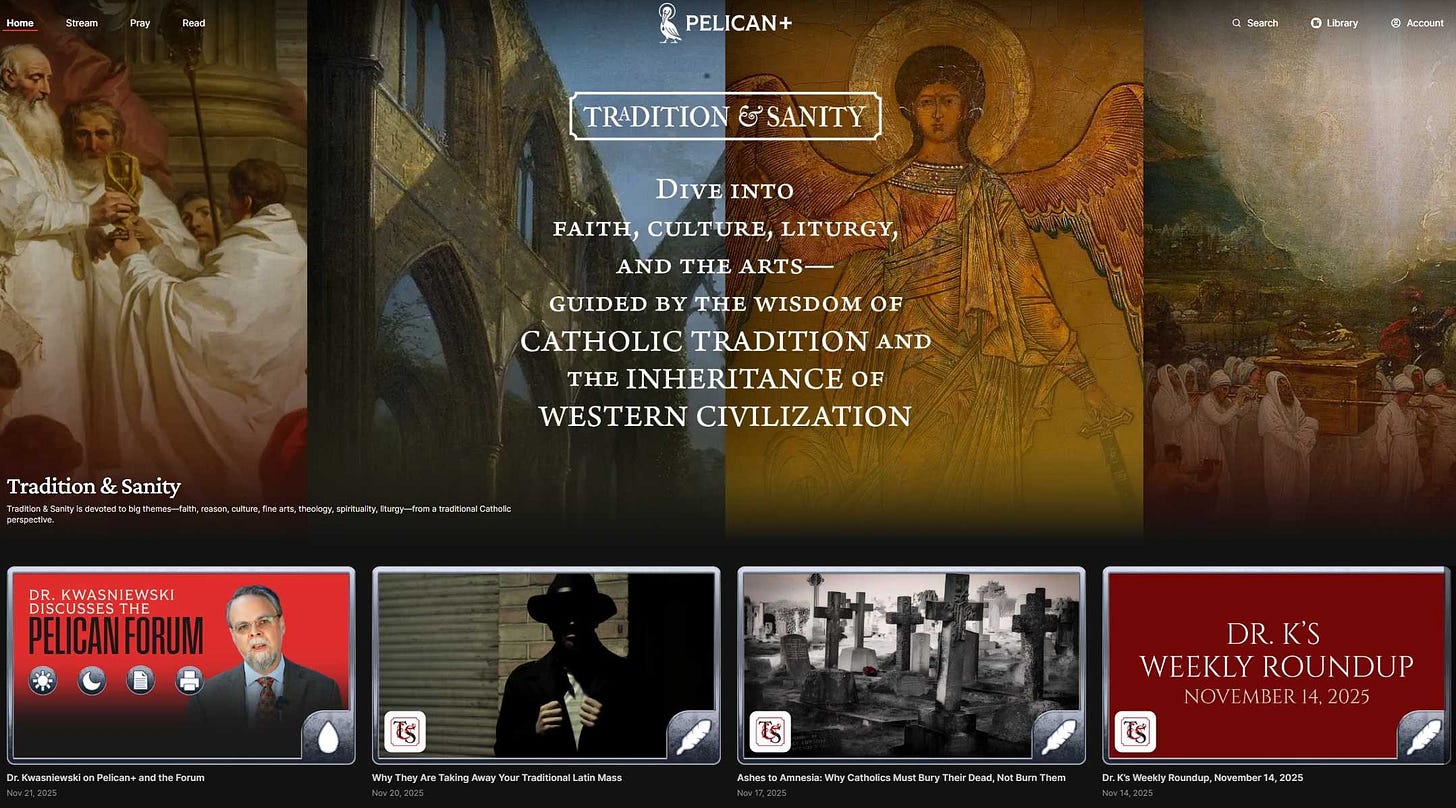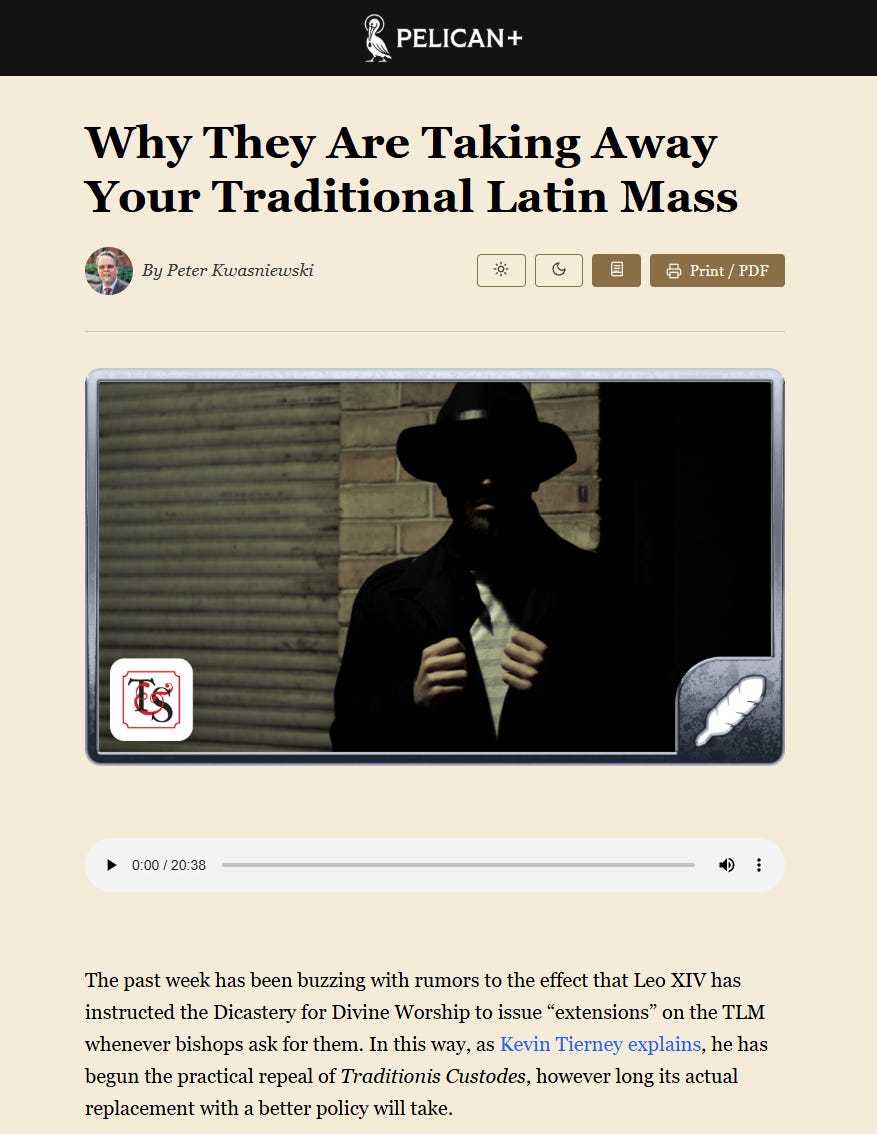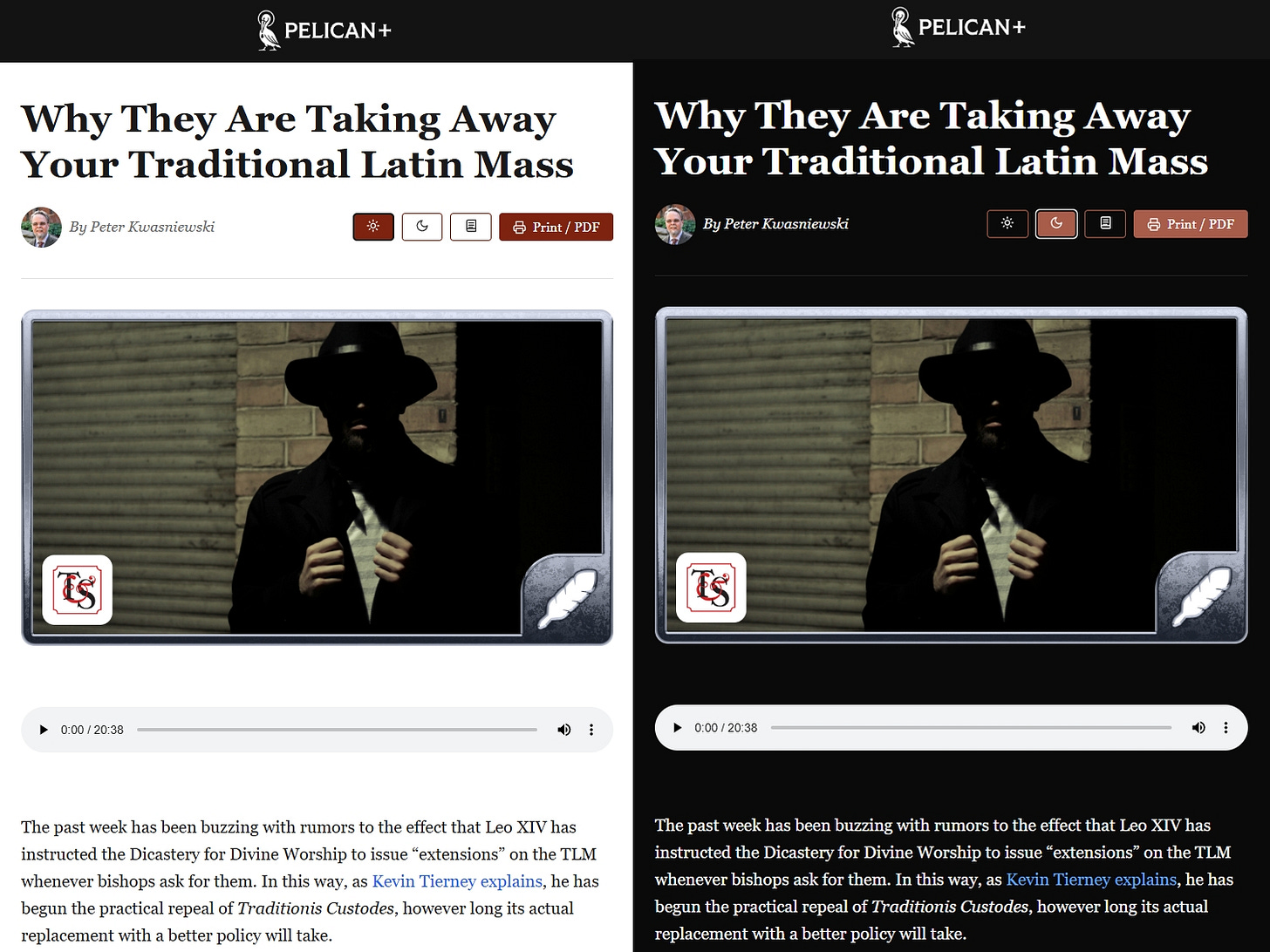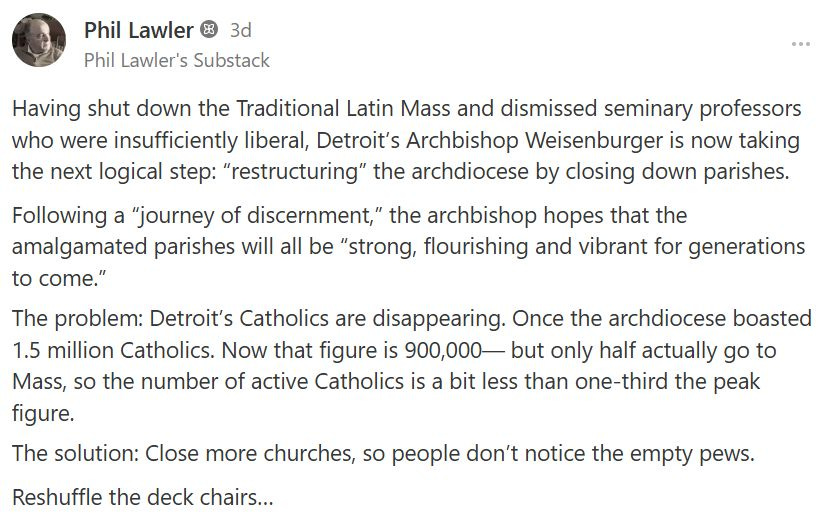Dr. K’s Weekly Roundup, November 21, 2025
Much to discuss so let’s dive right in. First, some Pelican+ updates, and then the usual Weekly Roundup.
New features at the Pelican Forum
As I’ve mentioned a few times before, the permanent home of Tradition & Sanity as of December 1 will be Pelican+. This Substack will not close down, but it will become something of a bulletin board telling you about the latest posts over there.
I want to say a big thank you to all the subscribers who have moved from here to there in recent weeks!
For those who haven’t:
If you’re an annual subscriber and would like to receive a voucher to apply to a Pelican subscription, just write to team@piouspelican.com. Once you use the voucher, you’ll be automatically unsubscribed here — no extra step needed.
If you’re a monthly subscriber, just cancel here and then sign up for a basic membership over there—it’s the same price, or actually, a bit less if you use this coupon code.
If you’re a free subscriber here, you can sign up at Pelican+ for a free account that will get your foot in the door.
The momenum at Pelican is incredible: the incoming traffic is soaring, as we continue to add writers, podcasters, moviemakers, and journalists (most recently, Michael Haynes and Charles Coulombe), and as we continue to expand the prayer app with traditional prayers read by real human beings, not by AI bots or dodgy celebs.
If you haven’t had a chance yet to visit Pelican+, please take a moment to look around. (If you’d like to go straight to Tradition & Sanity’s page, use this link.)
Of greatest interest to Substack users will be some major improvements we’ve made in Pelican’s Forum section (symbolized by a quill in the lower right corner of a thumbnail), which is where articles are posted. Here’s a screenshot of my last article as it appears over there:
You’ll notice in the bar next to my name three buttons. These represent light mode, night mode, and parchment mode — you can select the background that you find most pleasant for reading. Above is parchment mode; below, light and dark.
You’ll also notice a button that says “Print / PDF.” Yes! We listened to our readers who asked for the ability to print out a post or save it as a PDF.
Whenever there’s a voiceover, you’ll find the audio access directly under the main image.
Moreover, with Pelican+’s internal Substack-like editor (called “Quill”), we have now been able to make serious headway in porting all of the earlier Tradition & Sanity posts over to Pelican+, so that soon the over 450 posts that have gone up here since April 2023 will also be found there under the same titles, easy to search for and locate, or to browse until you see topics that interest you.
Here’s a short (8-minute) video about why I decided to move Tradition & Sanity to Pelican+, and what readers can expect to find there:
For those who are still wondering “What’s all this fuss about Pelican+?,” I recommend having a look at some older posts here where I talk about why it’s such a godsend for tradition-loving Catholics:
Three Recent Podcasts
It’s been a busy time for me in the interview domain!
Matt Fradd invited me to do a second podcast for Pints with Aquinas, this time on “Music, Art, and the Recovery of the Sacred”—but we also spent a lot of time on the question of modernity and technology:
My friend and fellow composer Mark Nowakowski makes a point over at OnePeterFive (“Catholicism and Musical Culture – from Taylor Swift to Pärt and onward”) that parallels some of my comments to Fradd:
One can easily observe that the prolonged decline of popular culture has spiraled into a dirty ditch and has been bottom-bouncing ever since, while what we are witnessing is a continued addiction to an aural drug....
Music is exceptionally powerful inthe narcotic qualities and sense of religious adulation that a well-produced and catchy song can create. The music industry has known this since at least the mass hysteria inspired by the Beatles. Christians also reacted badly when John Lennon said that the Beatles were “more popular than Jesus,” instead of taking this as the accurate criticism and warning that it was. His words are still true.
Since those heady days of shrieking Beatle-mania, the industry has refined its production techniques to a fine science, and have made billions in the process. Your captured attention is their specialty, and you can be assured that any concern for your emotional or spiritual health is of no concern.
Katherine Bennett and Mark Lambert invited me on to Catholic Unscripted to discuss the state of Catholic education, how it was undermined by the Land O’Lakes statement, how an intrepid group of small colleges resisted the trend, and why there is hope for the future — most recently embodied in the formation of a new college in the midwest, The College of Saint Athanasius, which I introduce to viewers:
Speaking of education, Robert Keim revisits John Senior’s Thousand Good Books, fifty years later.
Lastly, Matt Gaspers engaged me in conversation on Catholic Social Teaching centered on the Kingship of Christ, anent the release of my latest book, His Reign Shall Have No End:
Episcopal Corner
Ideal bishop
If you want to know what a saintly bishop looks like, how he acts, what he does, read this account of St. Charles Borromeo.
Not-ideal bishop
Why is it always the same playbook? Well, that’s what I tried to explain in yesterday’s post…
A new article by James Green offers support to my thesis: “Commissar [James] Martin.”
Either you laugh or you cry
Here’s a product that would be handy (or kneely) not only in Austin, where the incoming bishop made it his first priority to discourage kneeling for Holy Communion at Mass, but also in Charlotte, and soon other places where the sodomodernist agenda unfolds:
(I’m sorry but I don’t remember where I picked this up, and I apologize for not giving due credit. If you happen to see this, leave a comment with the URL where it first appeared.)
Canceled Bishop
In many ways, “The Strange Path of Fr. Joe” is a fine and moving article about Bishop Strickland. However... how exactly would the scenario of a minority of orthodox, heterosexual bishops standing up to their peers or superiors and then being “retired from” office actually help the faithful? It seems to me that the example of the late, great French archbishop—I hardly need to say his name—is a beacon: he continued to shepherd the beleaguered sheep even after he was illicitly canceled.
“US Coffee Circle of Bishops”
In a scathing article of that title, Sheryl Collmer writes:
The fall general assembly of the USCCB lumbered into session last week at the Marriott Waterfront in Baltimore, as they do each November. The ponderous livestream of bishops, all doing their best to be flavorless, was, to say the least, somnolent. There were approximately two minutes of interest on day two, when Bishop Strickland stood up to make an intervention. He was widely ignored, after which the porridge of officialdom moved on like a slow-moving river around a midstream boulder. It felt like they all found something of interest on the ceiling.
It is finally becoming apparent, even to the most hopeful, that no amount of begging, pleading, or shaming will cause the bishops to care about the laity and those things that are most important to us. If they’re confused as to what those things are, a good start would be to ask priests what they hear most in Confession. I guarantee it’s not offenses against climate change or synodality.
Vibe shift for TC
In case you missed it, Kevin Tierney explains why Leo’s policy of granting easy exceptions to Traditionis Custodes is the crack in the dam.
A book for our times
Many people thanked me for yesterday’s post, “Why They Are Taking Away Your Traditional Latin Mass.” And yet… I understand that it was sobering, enough to cause even strong souls to shudder.
One remedy that many spiritual masters insist on is having good spiritual reading always to hand. I’ve been meaning to tell you about a new book of spiritual reading published by Arouca Press: Spes Nostra: Profound Words of Encouragement & Consolation for Weary Members of the Mystical Body. In it, you’ll find hundreds of short passages from the saints — absolute gems, perfectly chosen and arranged, speaking straight to the heart and to the difficulties of the times we’re living in.
While there are a fair number of books with “kindling” like this for meditation and prayer, this is my all-time favorite.
Our Lady
One of the most helpful articles I’ve read so far about the DDF dust-up over Our Lady’s titles: “Read Staglianò to understand opposition to Mary ‘Coredentrix’.” (That last word should be Co-redemptrix, but the editors who prepared the English version from the Italian original were not awake on the job.) It’s not long, but it is laser-focused.
Theologian Antonio Francés also weighs in on the discussion of whether “Co-Redemptrix” is an appropriate title (hint: not only is it appropriate, but it cannot be said to be inappropriate).
Msgr. Richard Antall writes, in “An Inopportune Doctrinal Note”:
An old priest once used a metaphor to describe how the higher-ups in the Church sometimes were out of touch with the faithful: “They have no idea of how that works when you’re in the trenches. Their desks are too far away from the line of fire.”
Liturgical Lessons
Courtly spectacle?
In an article by Edward Pentin at the National Catholic Register, yours truly is quoted contra Cupich’s dumb take on the old rite as “courtly spectacle.”
Sober drunkenness as a lens
Fr. Z on “sobria inebrietas” as a lens through which to view the liturgy wars. Excellent reflection.
Beauty’s importance
There’s probably nothing that bothers me more, after sheer sacrilege, than the denigration of beauty as if it were a mere extra, window-dressing, a frivolity. The consequences of this attitude are devastating, and for this reason, as Marcello Veneziani puts it:
Beauty is a friend of moderation and the enemy of borderlessness; a friend of the real world and the enemy of the abstract; a friend of gift and the enemy of utility; a friend of excellence and the enemy of mediocrity; a friend of lightness and the enemy of heaviness; a friend of variety and the enemy of uniformity; a friend of distinction and the enemy of separation; a friend of myth and the enemy of calculating reason; a friend of space and the enemy of time; a friend of being and the enemy of nothingness.
Reading the signs
Robert Lazu Kmita, “Why Receiving Holy Communion in Hand is Wrong”:
The disappearance of the mystagogical culture and the understanding it generates is at the root of the destruction of the Holy Liturgy. Priests are the first who should become aware of this, educating us by their example to fulfill the ideal expressed by Saint Paul the Apostle: I live, now not I; but Christ liveth in me (Galatians 2:20).
The priest lives this to the highest degree whenever he celebrates the Holy Liturgy. If today, in the post-conciliar Church, we see clowns, tango dancers, and showmen of all kinds (besides the myriads of believers who serve themselves as in self-service restaurants), it is due to the cult dedicated to that “god” aptly called by Dr. Edward Feser “the idol of the self.”⁵ If he spoke about the enthronement of this idol “in the center of political and social order, usurping the place that rightly belongs to God,” I fear the same thing is also unfolding in the Church, which in recent decades has come to resemble the fallen world more and more, becoming a mere annex of it, and less and less an icon of the heavenly realm of God.
The awe-inspiring Roman Canon
Michael Foley writes about the “Nobis quoque.” Lots in here. Just a taste:
The numbering is also significant. The Communicantes begins with the Blessed Virgin Mary and, before the insertion of St. Joseph’s name in 1962, continues with twelve Apostles and twelve martyrs, i.e., 1 + 12 + 12. The Nobis quoque peccatoribus begins with St. John the Baptist, followed by seven male martyrs and seven female, i.e., 1 + 7 + 7. And, as Fr. Neil Roy observes, the placement of the Theotokos and the Precursor of the Lord at the head of each list (and on either side of the Consecration) creates a literary “deesis,” a triptych that depicts Christ flanked by His mother and His cousin.
Political Musings
Yes, this is Catholic doctrine
I had missed this fine article by Dr. John Joy, “The Theological Note of Integralism,” when it first appeared some years ago. Worth a read. He demonstrates that integralism, so far from being outmoded or outlawed, is part of the Church’s definitive teaching—even if, as Thomas Pink might say, the fashionable “official theology” of our day denies it or silently passes it by.
The strumpet squeaks
If you want a snapshot of just how diabolic the principle of laïcité (total separation of church and state) is and has become in France, read this piece by Joseph Pearce about the controversy over a Catholic documentary on the Sacred Heart that is enjoying unexpected success with the public—and therefore rousing the usual masonic ire.
Conserving hollow shells
Gavin Ashenden explains why today’s conservatism seems so wimpy:
Institutions like churches, universities, the great civic bodies that once gave shape to civilisation, the media, the historic professions, have already been captured by a managerial class of liberal-left activists who reshaped them from the inside out.
The tragic irony is that by trying to “preserve” the institutions, conservatives ended up preserving the engines of their own dispossession. They were guarding buildings whose souls had already been evacuated. They became caretakers of structures now dedicated to perpetual cultural revolution....
Every major institution in the West — universities, Protestant churches, and increasingly the Catholic Church (not least after Vatican II — and let’s get there later), the media, foundations, state education, and a large number of corporations — has already been captured by this managerial elite.
The process unfolded between the 1930s and 1970s, and has only deepened since. By the time conservatives mobilised to “defend” these institutions, they were already defending shells that now served the ideological purposes of their opponents.
Miscellany
If they’re having fun, it must be wrong
Over at Unam Sanctam, you’ll find an intriguing article (“Dancing, Moral Panics, and Boomerism”) on some historical dynamics concerning the condemnation of popular pastimes, especially dancing. After having shown how repeatedly in history a certain type of person insists on condemning harmless pastimes, the author rousingly concludes:
In our own day, as well, we see immense social transformation, coupled with deep-seated concerns about everything young people are doing. But if social transformation has brought new dangers, it also brings new remedies. In an age where the majority of Americans are obese from a hyper-sedentary lifestyle, where digital interactions and online dating have upended relations between the sexes, where young people rot in their beds alone for hours on end scrolling porn and gooning, where 45% of women are predicted to be single and childless by 2030, social dancing is the last thing we need to worry about. In fact, social dancing is a wholesome and robust remedy to the crippling isolation and self-referential nature of modern life.
Becoming more human again
As Matt Fradd and I discussed, we both use technology to reach people with a message that is pre-technological and supra-technological. In other words, we agree that, as helpful as our devices are, we need to make sure we’re doing the things, the kinds of things, that will foster a fulfilled human life according to God’s designs for our nature—and especially His designs for our adoption as sons in the Son.
For this reason, I find absolutely compelling the following synopsis of “A Human Creed” presented by Ruth and Pico Gaskovski:
Read more at their Substack, The School of the Unconformed.
Torches Against the Abyss
I recently joined Fr. John Perricone on Ben Harnwell’s program at Bannon’s War Room to discuss Father’s runaway success, Torches Against the Abyss, as well as why I started Os Justi Press, and the situation of the Catholic Church today. You can view the 25-minute segment here.
Thank you for reading and may God bless you!














Dancing always seemed to be an answer to human needs in Jane Austen's novels. And Alasdair MacIntyre cited her as a moral thinker in "After Virtue," so that settles it for me. Along those same lines, one of the best modern film makers, Whit Stillman, follows Austen's lead in all his movies and features dancing. So there, critics of (good, not immoral) dancing.